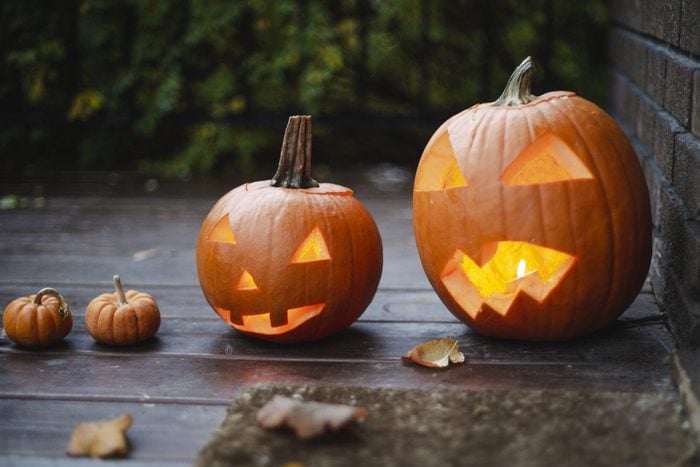The History of Jack-o’-Lanterns and How They Became a Halloween Tradition
Updated: Oct. 31, 2022

Why do we carve pumpkins on Halloween? This fun tradition dates way, way back to ancient customs and a spooky tale.
Every October, ghoulish gourds peer out from doorsteps across the country. But what is it about the crisp air, changing leaves, and end of summer that urges us to break out the carving knives and carve jack-o’-lanterns? Halloween is filled with odd traditions, Halloween colors, and even games like bobbing for apples, many with a rich history. Halloween jack-o’-lanterns are no exception. Although jack-o’-lanterns adorning every doorway are the norm, most people don’t know why. We’ll share the secret of the season’s most ubiquitous decoration. Their origin has to do with the explanation behind what Halloween is itself.
What is a jack-o’-lantern?
A jack-o’-lantern is, as the name might suggest, a lantern—one made out of a root vegetable. (Nope, it doesn’t have to be a pumpkin—more on that later!) Perhaps you’ve made one yourself, using pumpkin carving stencils to create a face or design in a pumpkin. But this is somewhat of an odd tradition when you think about it. How did it originate?
The history of jack-o’-lanterns
“In every ancient pagan tradition worldwide, people honor their dead, their ancestors,” says Cerridwen Fallingstar, Witch, teacher, and author of Broth from the Cauldron: A Wisdom Journey through Everyday Magic. “In Celtic countries, notably Scotland and Ireland, people would bury the dead, and then…they would dig up the skull and place it on a shelf inside a barrow, or burial mound. On Samhain, the day of the dead that we now call Halloween, people would enter the mound and light a candle inside one or more of the skulls that were present there.” Sound familiar? No wonder jack-o’-lanterns evoke a creepy feeling—they began as real skulls! Fallingstar says that the celebrants would even speak to their ancestors using the skulls.
There’s a lot more to cover about the history of Halloween and how Samhain became the celebration we know today. The time of Samhain, now Halloween, was believed to be a time when the boundary between the worlds of the living and the dead was especially weak. “People would set out food for their beloved dead. But while they craved contact with the spirits of those they loved, they feared that malevolent spirits were also walking that night, and sought protection against them,” Fallingstar explains. As the holiday evolved, celebrants moved away from real skulls and “took to carving ‘skulls’ out of large turnips and setting a candle to burn inside—that would welcome their loved dead, yet frighten the supernatural creatures they feared.”
The “Jack” of Halloween jack-o’-lanterns: Stingy Jack
Many of the immigrants responsible for the popularity of the jack-o’-lantern in the United States—and its name—were Irish, what with Samhain’s Celtic origins. “Stingy Jack is a later Irish myth used to try to explain a custom which was obviously pagan, which was not safe to acknowledge once Christianity came into power,” says Fallingstar. That myth? According to folklore, Jack was a devious fellow who met the devil one fateful night. The duo shared a drink and, too cheap to pay for his booze, Jack convinced Satan to morph into a coin that he could use to pay for their beverages. As soon as he did, Jack put the coin in his pocket next to a silver cross. The devil was unable to change back into his original form, and Jack held him that way until Satan agreed not to take his soul. Sneaky!
Shortly after his meeting with the devil, Jack died. As the legend goes, God would not accept Jack into Heaven and sent him down to visit the devil in Hell. But the devil kept his promise. He wouldn’t let Jack into Hell, either. The devil sent Jack into the dark night to roam the world for eternity, with only a coal to light his way. Jack lit the coal, put it in a hollowed-out turnip, and has been drifting through the world, scaring children ever since. Townsfolk began to refer to this figure as “Jack of the lantern” and shortly thereafter “Jack o’ lantern.” Like the ancient pagans, believers of this myth began to carve their own lanterns out of turnips, beets, potatoes, and eventually pumpkins in hopes of warding away any ghostly spirits.

How jack-o’-lanterns have changed throughout history
At this moment you’re likely wondering why people don’t have turnips sitting on their doorsteps in October! Well, the pumpkin aspect of the tradition is uniquely American, as Fallingstar explains. “When Europeans came to America, they discovered pumpkins, a Native American crop which, besides being tasty, they recognized would make fabulous jack-o’-lanterns,” she says. “Though they were not skull-white like turnips, they were large and easy to carve and cast a benevolent golden light.”
As years went by, the spooky history behind this family tradition has been lost. So now carving pumpkins is synonymous with family and fun instead of spooky spirits. But this October, when you reach for a warm glass of cider and a carving knife, spook your friends and family with this ghostly tale! Check out these other origins of Halloween monsters too.
Jack-o’-lanterns in other cultures
“Lighting candles is a near-universal way to beckon the dead in cultures which still call them to return for one night,” says Fallingstar. For instance, you can see this custom in the Mexican Día de Muertos. “But I think only the Celtic culture uses imitation skulls called jack-o’-lanterns to welcome some and banish others,” she adds. However, she says that Japan does have a somewhat similar tradition: “The Japanese light four-sided paper lanterns on small wooden rafts and send them down rivers to guide their beloved spirits back home on a stream of light on their day of the dead, which they call Obon.” In addition to your jack-o’-lantern, here’s some other budget-friendly Halloween decor to try out this year. If you don’t have time to carve a jack-o’-lantern this year, check out these no-carve pumpkin ideas for Halloween.
Sources:
- Cerridwen Fallingstar, Witch, teacher, and author of Broth from the Cauldron: A Wisdom Journey through Everyday Magic
- History: “How Jack O’Lanterns Originated in Irish Myth”



